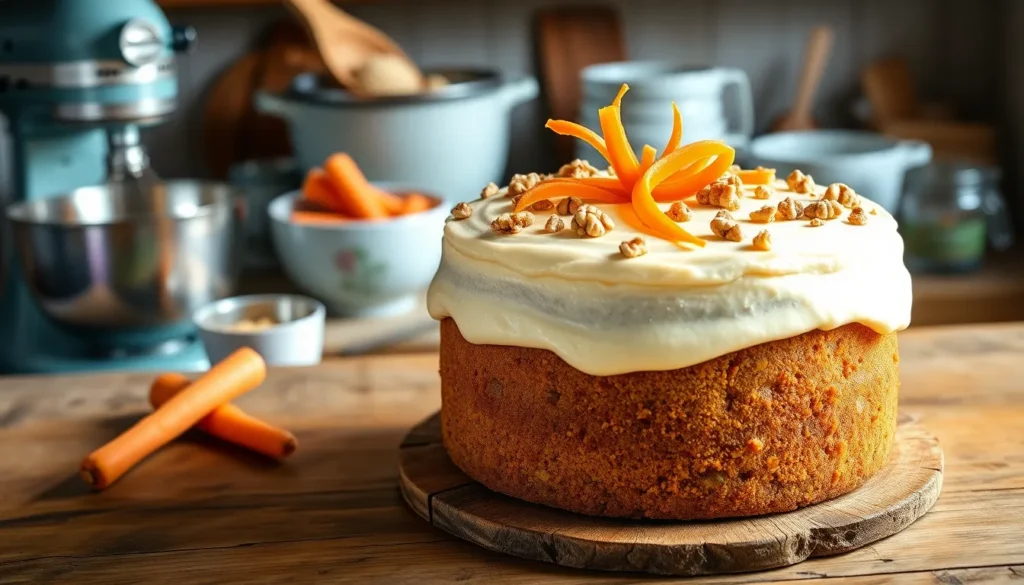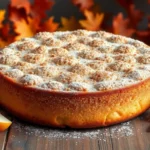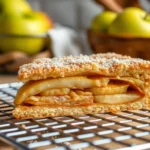Few desserts capture hearts quite like a perfectly moist carrot cake. This beloved American classic transforms humble carrots into something magical – a tender spiced cake that’s both comforting and sophisticated. What started as a practical way to sweeten cakes during sugar shortages has evolved into one of our most cherished desserts.
We’ve perfected this homemade carrot cake recipe to deliver everything you crave: incredibly moist layers packed with warm spices like cinnamon and nutmeg plus the perfect balance of sweetness. Fresh carrots provide natural moisture and subtle sweetness while creating that signature tender crumb that makes carrot cake irresistible.
Whether you’re celebrating a special occasion or simply want to treat your family to something extraordinary this easy carrot cake delivers bakery-quality results every time. Get ready to fill your kitchen with the most amazing aromas and create a dessert that’ll have everyone asking for seconds.
Ingredients
Gathering the right ingredients is essential for creating our perfect carrot cake. We’ve carefully selected each component to ensure optimal flavor and texture in every bite.
For the Carrot Cake
- 2 cups all-purpose flour
- 2 teaspoons baking soda
- 2 teaspoons ground cinnamon
- 1 teaspoon salt
- 1/2 teaspoon ground nutmeg
- 1/4 teaspoon ground cloves
- 1 1/3 cups vegetable oil
- 4 large eggs at room temperature
- 1 1/2 cups granulated sugar
- 1/2 cup light brown sugar packed
- 1 teaspoon vanilla extract
- 3 cups finely grated fresh carrots (about 1 pound)
- 1 cup chopped walnuts (optional)
- 1/2 cup golden raisins (optional)
For the Cream Cheese Frosting
- 16 ounces cream cheese softened to room temperature
- 1 cup unsalted butter softened to room temperature
- 4 cups powdered sugar sifted
- 2 teaspoons vanilla extract
- 1/4 teaspoon salt
For the Garnish
- 1/2 cup chopped walnuts
- 2 tablespoons shredded coconut (optional)
- Fresh carrot curls for decoration (optional)
Equipment Needed

Getting the right equipment makes all the difference when we create our perfect carrot cake. We need exact tools to achieve that bakery-quality texture and presentation that makes this dessert truly special.
Baking Essentials
Two 9-inch round pans form the foundation of our standard carrot cake layers. These pans ensure even baking and create those beautiful, professional-looking cake tiers. For those times when we want individual portions, muffin trays become essential for creating delightful mini carrot cakes that are perfect for parties or portion control.
Mixing Equipment
| Equipment Type | Purpose | Alternative Options |
|---|---|---|
| Hand Mixer or Stand Mixer | Large batch mixing and prolonged mixing tasks | Hand whisk (for smaller batches) |
| Wooden Spoon or Rubber Spatula | Scraping bowl sides and folding ingredients | Silicone spatula |
Our mixing equipment determines how well we incorporate all those wonderful ingredients. A hand mixer or stand mixer handles the heavy lifting when we work with large batches or need extended mixing time. The rubber spatula becomes our best friend for scraping every bit of batter from the bowl and gently folding in our grated carrots and nuts.
Preparation Tools
Fresh carrot preparation requires exact tools for optimal results. We need a sharp knife and chopping board for any nuts or additional ingredients. The vegetable peeler removes carrot skins efficiently, while our grater transforms those peeled carrots into the perfect texture for our cake batter.
Measuring Precision
Accurate measurements separate good carrot cakes from extraordinary ones. A digital scale provides the precision we need for consistent results every time we bake. Measuring spoons handle our spices and smaller dry ingredients with the accuracy that makes our warm cinnamon and nutmeg flavors shine through perfectly.
Final Essentials
A fine mesh sieve ensures our flour and dry ingredients blend smoothly without lumps. Multiple mixing bowls give us the workspace we need, with larger bowls for our main batter and smaller ones for beating eggs or preparing our cream cheese frosting. These tools work together to create the seamless baking experience that produces our moist, flavorful carrot cake layers.
Instructions

We’ll walk through each step to create our perfect carrot cake with rich cream cheese frosting. These detailed instructions ensure bakery-quality results every time.
Prep the Ingredients
For the Cake:
- 2 cups all-purpose flour
- 1 teaspoon baking powder
- ¾ teaspoon baking soda
- ½ teaspoon salt
- 1 teaspoon ground cinnamon
- ¼ teaspoon ground ginger
- ¼ teaspoon ground nutmeg
- 2 cups grated carrots
- ⅔ cup packed light brown sugar
- ½ cup granulated sugar
- 3 large eggs
- ⅔ cup sunflower oil
- ½ cup plain full-fat yogurt
- ⅓ cup pure maple syrup
- ½ cup chopped walnuts (optional)
- ½ cup soaked and drained raisins (optional)
For the Cream Cheese Frosting:
- ½ cup unsalted butter, softened
- 1 ⅔ cups powdered icing sugar
- 1 block cream cheese, softened
- 1 ½ teaspoon lemon juice
- ½ teaspoon vanilla extract
We begin by bringing our butter and cream cheese to room temperature for smooth frosting. Grate our carrots using a box grater or food processor for uniform texture. Soak raisins in warm water for 10 minutes then drain thoroughly if using.
Make the Cake Batter
We combine all dry ingredients in a large mixing bowl and whisk together thoroughly. Our flour mixture should be evenly distributed with no clumps remaining. In a separate bowl we whisk together both sugars and eggs until well combined. We add sunflower oil, yogurt, and maple syrup to our wet ingredients and mix until smooth.
Next we fold our grated carrots into the wet mixture ensuring even distribution. We pour the wet ingredients into our dry ingredients and gently fold together using a rubber spatula. Careful not to overmix as this creates a dense cake texture. Finally we fold in our chopped walnuts and drained raisins if using.
Bake the Cake
We preheat our oven to 350°F (175°C) and grease two 9-inch round cake pans thoroughly. Line the bottom of each pan with parchment paper for easy removal. We divide our batter evenly between the prepared pans using a kitchen scale for accuracy.
Our cakes bake for 35-40 minutes until a toothpick inserted in the center comes out clean. We avoid opening the oven door during the first 30 minutes to prevent sinking. Once baked we cool the cakes in their pans for 10 minutes before turning out onto wire racks to cool completely.
Prepare the Cream Cheese Frosting
We beat our softened butter and cream cheese together using a hand mixer or stand mixer until completely smooth. No lumps should remain in our mixture. Gradually we add powdered icing sugar one cup at a time, beating well after each addition.
Our frosting comes together when we add lemon juice and vanilla extract, beating until light and fluffy. We scrape down the sides of our bowl frequently to ensure even mixing. The finished frosting should hold its shape when piped but spread easily with an offset spatula.
Assemble and Frost the Cake
We level our cake tops using a serrated knife to create flat, even surfaces for stacking. Our bottom layer goes on a serving plate with a thin layer of frosting spread evenly across the top. We place our second layer on top and press gently to secure.
First we apply a thin crumb coat of frosting all over our cake to seal in loose crumbs. We chill this for 30 minutes until the frosting sets firm. Finally we apply our remaining frosting in a thick, even layer using an offset spatula. We can decorate with piping techniques or sprinkle chopped walnuts around the edges for an elegant finish.
Storage Instructions
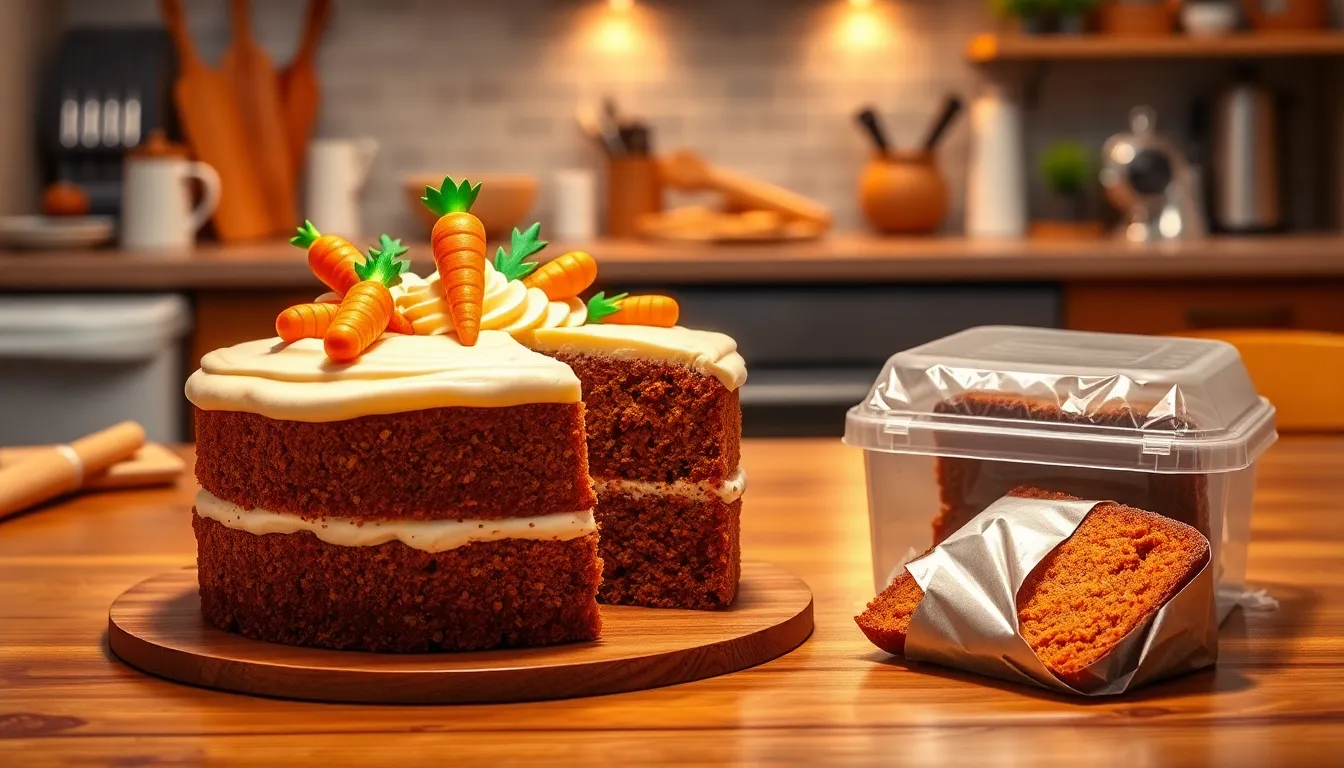
Proper storage extends the life of our carrot cake while preserving its moist texture and rich flavor. We recommend following exact guidelines based on whether you plan to serve the cake immediately or save it for later enjoyment.
Room Temperature Storage
Our freshly baked carrot cake stays delicious at room temperature for limited periods. Homemade carrot cake maintains optimal quality for 1-2 days when stored properly at room temperature. Store-bought varieties typically last 2-3 days under similar conditions.
We always wrap our cake tightly in plastic wrap or place it in an airtight container to prevent moisture loss. This protection keeps the cake from drying out and absorbing unwanted odors from the surrounding environment.
Refrigerator Storage
Refrigeration significantly extends our carrot cake’s freshness and safety. Homemade carrot cake stored in the refrigerator maintains quality for 4-5 days. Store-bought versions can last 5-7 days when properly refrigerated.
| Storage Method | Homemade Duration | Store-Bought Duration |
|---|---|---|
| Room Temperature | 1-2 days | 2-3 days |
| Refrigerator | 4-5 days | 5-7 days |
| Freezer | 2-4 months | 2-4 months |
Frosted carrot cakes require special attention during refrigeration. We ensure our cream cheese frosted cake cools completely before wrapping and refrigerating. This prevents condensation from forming and compromising the frosting’s texture.
Freezer Storage
Freezing offers the longest storage option for our carrot cake. Both homemade and store-bought carrot cakes freeze successfully for 2-4 months without important quality loss.
We recommend storing cake layers separately if we plan to freeze them unfrosted. This approach allows for easier thawing and assembly when we’re ready to serve. Wrap each layer individually in plastic wrap before placing in freezer-safe containers.
Essential Storage Tips
Proper wrapping techniques make the difference between fresh cake and dried-out disappointment. We use tight plastic wrap or airtight containers to create an effective moisture barrier. Multiple layers of protection work best for longer storage periods.
Temperature considerations affect our storage success. We avoid leaving carrot cake at room temperature for extended periods as this accelerates spoilage. Moving frosted cakes directly from baking to proper storage maintains optimal freshness.
Visual appeal matters during storage too. We cover any frosting imperfections with cake crumbs before storing to maintain an attractive appearance when serving time arrives.
Make-Ahead Tips
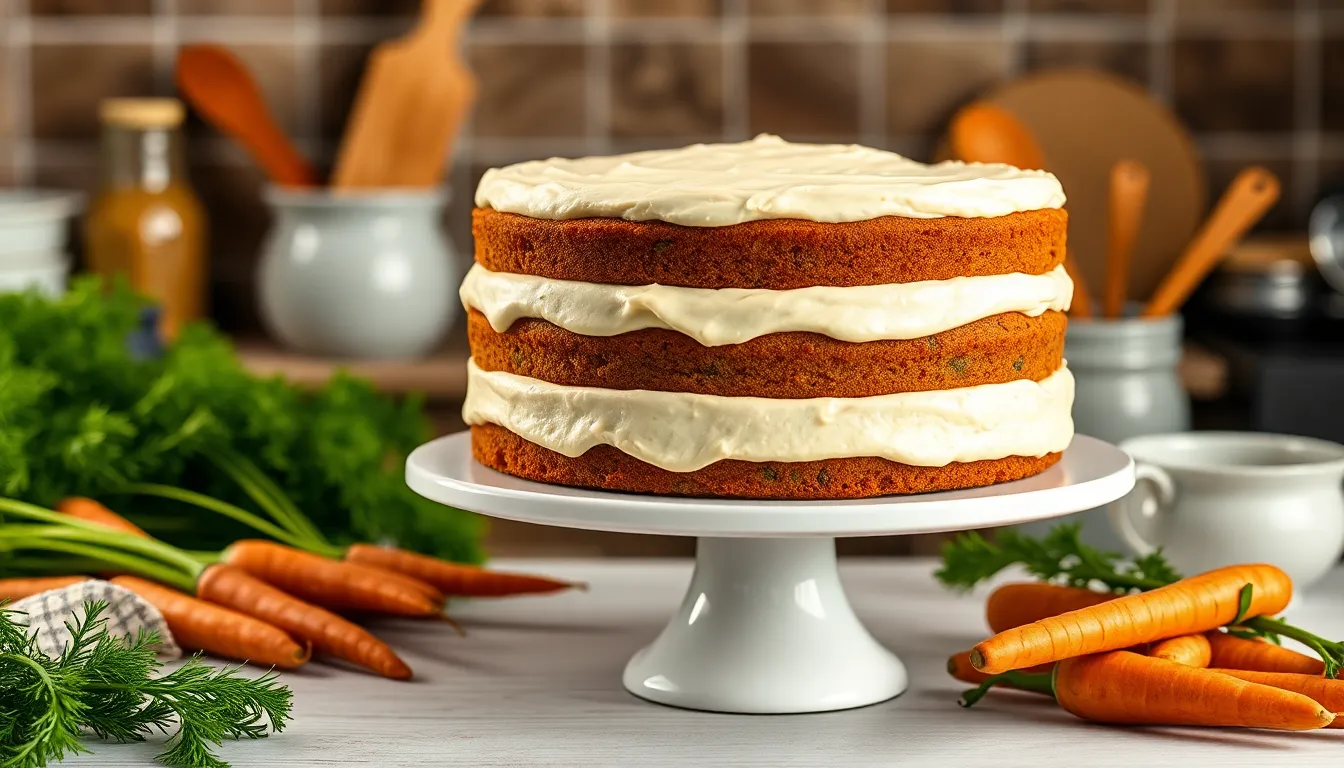
Planning ahead transforms carrot cake preparation from stressful to seamless, especially when entertaining guests or preparing for special occasions. We recommend utilizing these proven strategies to create our delicious carrot cake days before you need it.
Baking and Storage Timeline
Carrot cake layers respond beautifully to advance preparation, maintaining their signature moisture and flavor. We can bake our cake layers and store them at room temperature overnight, or refrigerate them for at least 2 hours before assembly. The optimal make-ahead window extends up to 3 days in advance, giving us flexibility for event planning.
Once our layers have cooled completely, we wrap each one tightly in plastic wrap or aluminum foil. Store the wrapped layers in the refrigerator to preserve their texture and prevent any flavor absorption from other foods.
Frosting Preparation Strategy
Cream cheese frosting can be prepared ahead of time and refrigerated until we’re ready to assemble our cake. We find it best to make the frosting just before assembly to ensure optimal freshness and the smoothest consistency. The frosting maintains its quality when stored properly in the refrigerator.
Assembly and Final Storage
After assembling our frosted carrot cake, we can refrigerate it for up to 3 days while maintaining peak quality. Store the completed cake in a sealed container to preserve its moisture and prevent the frosting from absorbing refrigerator odors.
Before serving, we chill the assembled cake for approximately 30 minutes. This crucial step allows the frosting to set properly and makes slicing significantly easier, ensuring clean cuts and professional presentation.
Moisture Enhancement Techniques
Several key ingredients work together to maintain our cake’s signature moistness during storage. Brown sugar, oil, and applesauce serve as natural moisture retainers that enhance both flavor and texture longevity. These ingredients prove especially valuable when preparing the cake in advance.
Freshly shredded carrots contribute superior moisture content compared to pre-packaged alternatives. We always shred our carrots at home to maximize the cake’s natural moisture and ensure the best possible texture throughout the storage period.
| Storage Method | Time Frame | Quality Maintenance |
|---|---|---|
| Room Temperature (layers only) | Overnight | Excellent |
| Refrigerated Layers | Up to 3 days | Excellent |
| Assembled Cake (refrigerated) | Up to 3 days | Excellent |
| Pre-assembly Chilling | 30 minutes | Optimal slicing |
Serving Suggestions
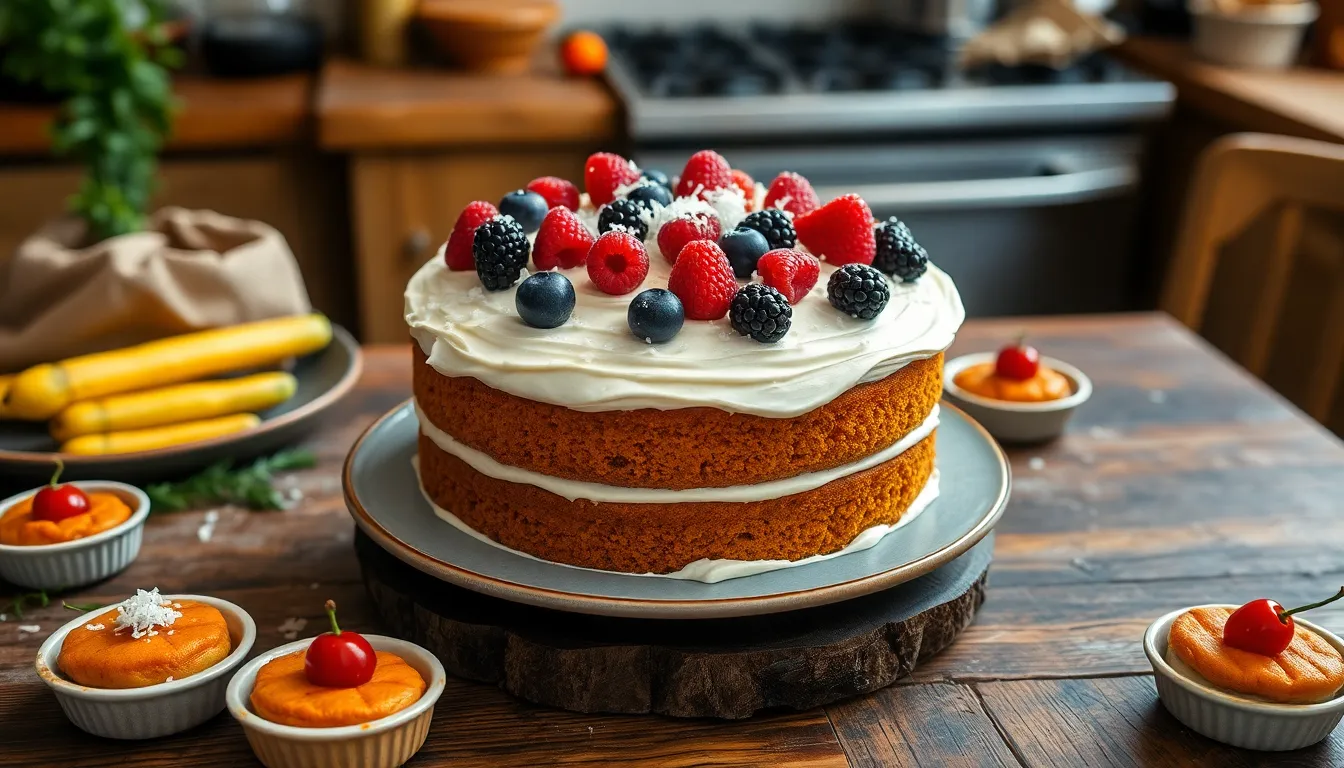
Our perfectly crafted carrot cake deserves presentation techniques that showcase its moist layers and rich flavors. We’ve discovered that the right toppings and accompaniments can elevate this beloved dessert from delicious to absolutely memorable.
Essential Toppings
Cream cheese frosting remains the gold standard for carrot cake pairings. This tangy and creamy combination creates the perfect balance against our cake’s warm spices and natural sweetness. We recommend applying it generously between layers and across the surface for that classic bakery appearance.
Powdered sugar offers a simpler approach when we want the cake’s natural flavors to shine. A delicate dusting adds just enough sweetness while creating an elegant visual contrast against the cake’s golden brown exterior.
Fresh fruit transforms our carrot cake into a vibrant dessert experience. Berries provide bursts of tartness that complement the cake’s sweetness. Pineapple chunks add tropical notes that pair beautifully with the warm spices. Mango slices contribute exotic flavors that make each bite more interesting.
Whipped cream delivers a light and airy texture that balances the cake’s dense richness. We find this topping particularly effective when serving carrot cake as an afternoon treat rather than a heavy dessert.
Shredded coconut introduces tropical flavors and appealing texture variations. Sprinkle it over frosted surfaces or mix it directly into whipped cream for enhanced visual appeal.
Lemon or vanilla frosting provides alternative flavor profiles for guests who prefer something different from traditional cream cheese. These options maintain the cake’s moistness while offering unique taste experiences.
Creative Accompaniments
Grilled vegetables create surprising but delightful contrasts when served alongside carrot cake. Asparagus spears or bell pepper strips provide light and healthy options that cleanse the palate between sweet bites.
Cornish hens or salmon can transform our carrot cake from dessert to part of a complete meal. These proteins work particularly well when prepared on a grill or in an oven for more substantial dining experiences.
Little carrot cakes allow us to create fun dessert spreads with multiple topping options. These bite-sized versions let guests customize their experience while maintaining portion control.
Popular Variations
| Variation Type | Description | Serving Style |
|---|---|---|
| Carrot Cake Cookies | Cookie version of classic cake | Individual servings with various toppings |
| Carrot Cake Monkey Bread | Traditional monkey bread with carrot cake flavors | Pull-apart sharing style |
| Carrot Cake Porridge | Breakfast option with carrot cake flavors | Warm bowl with morning accompaniments |
These serving suggestions ensure our carrot cake becomes the centerpiece of memorable dining experiences. Each option enhances the cake’s natural appeal while providing flexibility for different occasions and guest preferences.
Recipe Variations

We love exploring different ways to enjoy this classic dessert while maintaining the moist texture and warm flavors that make carrot cake so beloved. Each variation offers unique characteristics that cater to different preferences and dietary needs.
Spiced Carrot Cake
We enhance the traditional recipe by incorporating warm spices like cinnamon, nutmeg, and ginger to create deeper flavor complexity. These aromatic spices complement the natural sweetness of fresh carrots while adding comforting warmth to every bite. Our spiced version typically includes 2 teaspoons ground cinnamon, 1/2 teaspoon ground nutmeg, and 1/4 teaspoon ground ginger mixed directly into the dry ingredients. The result delivers a more sophisticated flavor profile that transforms the familiar dessert into something extraordinary.
Carrot Cupcakes
We transform the classic layer cake into individual portions that offer convenience and customization options for any gathering. These portable treats maintain the same moist texture as traditional carrot cake while providing perfect portion control. Our cupcake version bakes in standard muffin tins for 18-22 minutes at 350°F and yields approximately 24 cupcakes. We top each cupcake with cream cheese frosting and often customize them with chopped walnuts, shredded coconut, or miniature carrot decorations. This variation works exceptionally well for parties, school events, or when we want to offer guests individual servings.
Gluten-Free Carrot Cake
We substitute traditional wheat flour with alternative flours to accommodate gluten sensitivities without sacrificing flavor or moisture. Our gluten-free version combines almond flour, oat flour, or rice flour to achieve the proper texture and structure. We recommend using 1 1/2 cups almond flour plus 1/2 cup oat flour as our preferred blend for optimal results. The finely grated carrots become even more important in this variation as they provide additional moisture and binding properties. We often enhance the frosting with coconut cream cheese frosting to complement the nutty flavors from alternative flours while maintaining the classic tangy-sweet balance.
Troubleshooting Tips
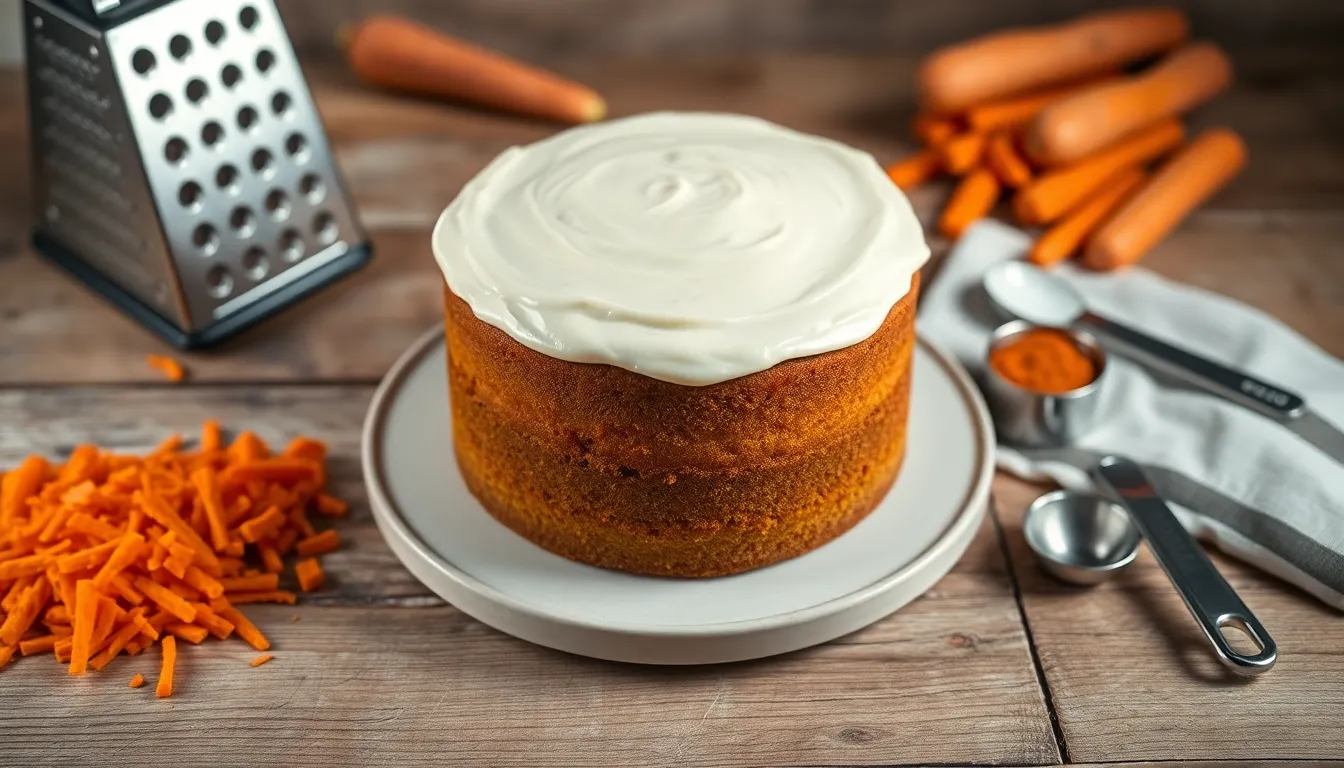
Even experienced bakers encounter challenges when making carrot cake. We’ve compiled the most common issues and their answers to help you achieve perfect results every time.
Raw or Underbaked Cake
The most frustrating problem occurs when your cake appears golden brown on the outside but remains raw inside. We recommend always testing for doneness by inserting a toothpick into the center of the cake. The toothpick should come out clean or with just a few moist crumbs attached. Pan size and color significantly affect baking time so adjust accordingly. Dark pans conduct heat faster than light colored pans requiring reduced baking time.
Collapsed Cake Structure
Nothing disappoints more than watching your beautiful cake collapse after removing it from the oven. We find this usually stems from expired leavening agents. Check your baking soda and baking powder expiration dates before beginning. Fresh leavening agents provide the necessary lift for proper cake structure. Also ensure you properly grease and flour your pans or use non-stick spray with flour to prevent sticking issues.
Dense Texture Problems
Dense carrot cake typically results from insufficient leavening or overmixing the batter. We recommend measuring baking soda precisely as it provides essential lift and airiness to the cake. Overmixing develops gluten in the flour creating a tough dense texture. Mix ingredients just until combined for optimal results.
Improper Carrot Preparation
Large carrot pieces create unpleasant crunchy textures in your finished cake. We suggest using the smaller shredding side of your box grater for finely grated carrots. Food processors with shredding discs produce even more uniform results. Properly grated carrots integrate seamlessly into the batter creating smooth texture throughout.
Wrong Fat Choice
Many bakers mistakenly substitute butter for oil in carrot cake recipes. We always use vegetable oil instead of butter because oil contains higher fat content that creates tender moist crumb. Oil also remains liquid at room temperature keeping the cake moist longer than butter based versions.
| Issue | Cause | Solution |
|---|---|---|
| Raw inside | Incorrect temperature/time | Test with toothpick, adjust for pan type |
| Collapsed cake | Expired leavening agents | Check baking soda/powder freshness |
| Dense texture | Overmixing or insufficient leavening | Mix just until combined, measure precisely |
| Crunchy carrots | Large grating | Use fine grater or food processor |
| Dry crumb | Using butter instead of oil | Use vegetable oil for moisture |
Conclusion
We’ve shared everything you need to create the ultimate homemade carrot cake that rivals any bakery’s finest offerings. From selecting the freshest ingredients to mastering proper storage techniques this comprehensive guide ensures your success every step of the way.
Whether you’re preparing for a special celebration or simply craving a slice of comfort food our detailed instructions and troubleshooting tips will help you achieve that perfect moist texture and rich flavor combination. The versatility of carrot cake means you can adapt it to suit any dietary preference or occasion.
Now it’s time to gather your ingredients preheat that oven and experience the joy of creating this timeless dessert. Your kitchen will soon be filled with those irresistible aromas and your family will be asking for seconds before you know it.
Frequently Asked Questions
What makes carrot cake so moist and flavorful?
The secret to moist carrot cake lies in using fresh grated carrots, vegetable oil instead of butter, and a combination of granulated and brown sugars. The carrots provide natural moisture and sweetness, while warm spices like cinnamon and nutmeg enhance the flavor profile. The oil creates a tender crumb that stays moist longer than butter-based cakes.
How long does homemade carrot cake last?
Homemade carrot cake lasts 1-2 days at room temperature, 4-5 days when refrigerated, and 2-4 months when frozen. Store-bought versions typically last slightly longer. Always wrap the cake properly in plastic wrap or store in an airtight container to maintain freshness and prevent the cream cheese frosting from spoiling.
Can I make carrot cake ahead of time?
Yes! You can bake cake layers up to 3 days in advance and store them wrapped in plastic wrap in the refrigerator. The cream cheese frosting can also be made ahead and refrigerated. Assemble the cake up to 3 days before serving, and chill for 30 minutes before slicing for clean cuts.
What equipment do I need to make bakery-quality carrot cake?
Essential equipment includes two 9-inch round pans, a hand or stand mixer, rubber spatula, digital scale, measuring spoons, sharp knife, vegetable peeler, and box grater. These tools ensure even baking, proper mixing, accurate measurements, and perfectly prepared fresh carrots for the best texture and flavor.
Why did my carrot cake turn out dense or collapse?
Dense carrot cake usually results from overmixing the batter, expired leavening agents, or incorrect measurements. Collapsed cakes often indicate old baking soda or powder. Mix ingredients just until combined, check expiration dates on leavening agents, and use a digital scale for precise measurements to avoid these issues.
Can I make gluten-free carrot cake?
Absolutely! Replace all-purpose flour with a combination of almond flour and oat flour to create a delicious gluten-free version. The recipe maintains the same moist texture and warm flavors as traditional carrot cake while accommodating dietary restrictions without sacrificing taste or quality.
What are the best toppings and variations for carrot cake?
Classic cream cheese frosting is traditional, but you can also use lemon or vanilla frosting, powdered sugar dusting, fresh fruit, whipped cream, or shredded coconut. Popular variations include carrot cupcakes, spiced carrot cake with extra cinnamon and ginger, carrot cookies, and even carrot cake monkey bread.
Should I use butter or oil in carrot cake?
Use vegetable oil instead of butter for the moistest results. Oil creates a more tender crumb and helps the cake stay moist longer than butter-based recipes. The neutral flavor of oil also allows the warm spices and carrot flavor to shine through without competing flavors.

